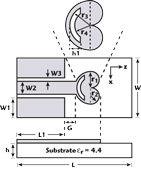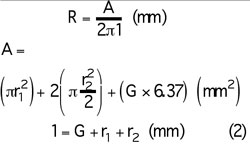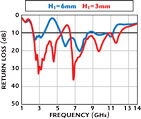
Many various configurations and various substrate materials for ultra-wideband (UWB) applications have been investigated.
Many printed broadband monopole configurations,1–3 such as circular, semi-circular and square shapes, can achieve ultra-wideband characteristics, omni-directional radiation patterns, simple structures, light weight and low cost.
The IEEE 802.15.3a standard4 specifies the 3.1 to 10.6 GHz frequency band for UWB communication systems.
However, the 5.15 to 5.825 GHz frequency band has been adopted by IEEE 802.11a5 for wireless local area networks (WLAN).

Interference can occur between UWB and WLAN systems. Two methods can be used to avoid this interference: a band-reject filter, or an antenna with a band-reject slot6–9 or slit.6,10 The use of a band-reject filter introduces a circuit complication and extra cost for UWB systems.
Antenna Design
The geometry of a printed heart-shaped monopole antenna11 is shown in Figure 1. It consists of a large half-disk and two small half-disks.
The large half-disk, with a radius r1, and two small half-disks, with identical radii r2, together with a 50 Ω CPW feed line, are printed on an FR4 substrate, with a thickness h = 1.6 mm and a relative permittivity εr = 4.4. W and L are the width and length of the substrate, respectively. W1 and L1 are the width and length of the coplanar ground planes, respectively.

The width of the center strip of the CPW feed line is W2 = 6.37 mm. The gap between the center strip of the CPW feed line and the ground plane is W3 = 0.5 mm. With these dimensions, the impedance of the CPW line is 50 Ω. G is the distance between the heart and the ground plane.
The proposed heart-shaped antenna gives a smoother transition than the conventional circular monopole; therefore, it is expected that the printed heart monopole antennas would have a better radiation performance, compared to the convectional printed circular monopole antennas.
The broadband and good radiation properties of the printed heart monopole antenna were investigated. In order to add a band-rejection characteristic into the heart-shaped monopole antenna, several approaches have been implemented and studied.
Figure 2shows the geometry of a printed heart-shaped monopole antenna with a rectangular slot.

The width of the rectangular slot is 2 mm. L2 and h1 are the length of the rectangular slot and the distance between the top of the big half-disk and the rectangular slot, respectively. When the length of the rectangular slot exceeds the boundaries of the shape of the heart, the rectangular slot will be changed into a ring-section slot.
Figure 3 shows the geometry of the printed heart-shaped monopole antenna with a ring-section slot. It consists of a big arc and a small arc. R3 is the distance between the big arc and the top of the big half-disk and r4 is the distance between the small arc and the top of a big half-disk.
The height of the ring-section slot is h1. Figure 4 shows the geometry of the printed heart-shaped monopole antenna with a uniform angle ring-section slot.
The ring-section slot consists of a big arc and a small arc. R3 is the distance between the big arc and the top of the big half-disk and r4 is the distance between the small arc and the top of the big half-disk.

The flare angle of the ring-section slot is θ. The desired lowest operating frequency (fL) of the printed heart-shaped monopole antenna can easily be determined from the following formulas12

where r is the equivalent radius of the proposed monopole antenna, determined by


where A is the area and 1 is the total height of the proposed antenna.
The heart-shaped monopole antenna is not a regular planar monopole antenna, so the original parameter 0.221 in Equation 1 has been replaced by 0.24.
For the proposed design, the center frequency of the rejected band is determined by the longest side of the slot etched into the heart-shaped monopole antenna.

The longest side of the slot is approximately a half wavelength at the center frequency of the rejected band.
Experimental Results and Discussion
The original printed heart-shaped monopole antenna provided a very wide bandwidth, larger than 10 GHz.11 The measured bandwidth, for a return loss greater than 10 dB, is from 2.48 to 13.35 GHz. Hence, an impedance bandwidth of approximately 137 percent has been obtained. For the purpose of avoiding interference between UWB and WLAN systems, an antenna with a band-rejected characteristic is proposed. The parameters that affect the performance of the proposed antenna have been investigated. They include the position and the height of the slot.
The return losses of the proposed antenna have been measured using a HP8720ES network analyzer from Agilent Technologies Inc. An optimal design, applicable to IEEE 802.16a13 and IEEE 802.15.3a (UWB)4 mobile wireless communication products, is proposed.
Printed Heart-shaped Monopole Antenna with a Rectangular Slot

Figures 5 and 6 show the return loss for different positions h1 of the rectangular slot, with L2 = 6 and 12 mm, respectively. The other dimensions are W = 35.07 mm, L = 46 mm, W1 = 13.85 mm, L1 = 20.67 mm, G = 0.8 mm, r1 = 16 mm and r2 = 8 mm. It shows that the bandwidth is sensitive to h1. For L2 = 6 mm, when the height of the rectangular slot is h1 = 12 mm, a band-rejected characteristic is shown.
Different Height h1 and Different Radius r4 for the Printed Heart Monopole Antenna with a Ring-section Slot. Figures 7 to 10 show the return loss for different heights h1 of the ring-section slot for r4 = 10, 11, 12 and 13 mm, respectively.
All the other dimensions are the same as previously. The distance r3 between the big arc and the top of the big half-disk is fixed at 14 mm.

As the value of h1 is changed, a band-rejected characteristic is shown.
The rejected band is strongly affected by h1, because the length of the ring slot is related to h1.
Different Angle θ of the Ring-section Slot and Different Values of r4 for the Uniform-angle Ring-section Slot
Figures 11 to 14 show the return loss with different flare angles of the ring-section slot for r4 = 10, 11, 12 and 13 mm. In this case, the distance r3 between the big arc and the top of a big half-disk is still fixed at 14 mm.

When the value of the angle of the uniform-angle ring-section slot is changed with r4 = 10, 11, 12 and 13 mm, a band-rejected characteristic of the printed heart antenna is observed.
As the flare angle θ increases, the rejected band shifts to a lower frequency.
Optimized Design
From this investigation and study, an optimized design of the antenna with a ring-section slot can be obtained. The effect of the gain drop of the printed heart monopole antenna with a uniform-angle ring-slot section is not significant.

Consequently, the geometry adopted is a printed heart-shaped monopole with a ring-section slot. The optimized parameters are εr = 4.4, h = 1.6 mm, h1 = 3 mm, W = 35.07 mm, W1 = 13.85 mm, W2 = 6.37 mm, W3 = 0.5 mm, L = 46 mm, L1 = 20.67 mm, G = 0.8 mm, r1 = 16 mm, r2 = 8 mm, r3 = 14 mm and r4 = 13 mm.Figure 15 shows the measured return loss of the printed heart monopole antenna and the proposed antenna.
The measured return loss bandwidth ranges are 2.30 to 5.02 GHz and 6.08 to 12.37 GHz, which are satisfactory for IEEE 802.16a and IEEE 802.15.3a (UWB) applications.

The input impedance of the proposed and printed heart monopole antennas are shown in Figure 16. The band-reject property of the proposed antenna is shown and proven. Figure 17 shows the measured peak gain of the proposed antenna. The gain drop over the rejected band is obvious. The measured radiation patterns measured at 2.4, 3.1, 7.0 and 7.5 GHz are shown in Figure 18. At these operating frequencies, the radiation patterns of the proposed antenna are suitable to IEEE 802.16a and UWB applications.
Conclusion
The design of a printed heart-shaped monopole antenna with a CPW feed line provides a very wide 
bandwidth, larger than 10 GHz. The measured bandwidth range, for a return loss greater than 10 dB, is from 2.48 to 13.35 GHz.
However, the 3.1 to 10.6 GHz frequency bands of the UWB systems overlap the 5.15 to 5.825 GHz frequency bands of the WLAN systems and an interference occurs between the UWB and WLAN systems.
A ring-section slot has been added to the printed heart-shaped monopole antenna to reject the 5.15 to 5.825 GHz frequency band. A novel design of a printed heart-shaped monopole antenna, with a ring-section slot, usable for IEEE 802.16a and IEEE 802.15.3a (UWB) applications, has been investigated and proposed.

The rejected band of this antenna can be controlled by varying the length of the ring-section slot etched within the printed heart-shaped antenna.
Acknowledgment
The financial support of this study by the National Science Council, Republic of China (Taiwan), under contact number NSC 94-2745-E-218-003-URD, is gratefully acknowledged.
References
- J. Liang, L. Guo and C.C. Chaiu, et al., “CPW-fed Circular Disc Monopole Antenna for UWB Applications,” 2005 IEEE International Workshop on Antenna Technology Digest, pp. 505–508.
- T. Yang and W.A. Davis, “Planar Half-disk Antenna Structures for Ultra-wideband Communications,” 2004 IEEE Antennas and Propagation Society International Symposium Digest, Vol. 3, pp. 2058–2511.
- J. Liang, C.C. Chiau and X. Chen, et al., “Study of a Printed Circular Disc Monopole Antenna for UWB Systems,” IEEE Transactions on Antennas and Propagation, Vol. 53, No. 11, November 2005. IEEE 802.15 Working Group for Wireless Personal Area Networks, http://grouper.ieee.org/groups/802/15/index.html.
- F. Cali, M. Conti and E. Gregori, “IEEE 802.11 Protocol: Design and Performance Evaluation of an Adaptive Backoff Mechanism,” IEEE Journal on Selected Areas in Communications, Vol. 18, No. 9, September 2000, pp. 1774–1786.
- K. Chung, J. Kim and J. Choi, “Wideband Microstrip-fed Monopole Antenna Having Frequency Band-notch Function,” IEEE Microwave and Wireless Components Letters, Vol. 15, No. 11, November 2005, pp. 766–768.
- S.W. Su, K.L. Wong and F.S. Chang, “Compact Printed Band-notched Ultra-wideband Slot Antenna,” 2005 IEEE Antennas and Propagation Society International Symposium Digest, Vol. 2B, pp. 572–575.
- T. Dissanayake and K.P. Esselle, “Design of Slot Loaded Band-notched UWB Antennas,” 2005 IEEE Antennas and Propagation Society International Symposium Digest, Vol. 1B, pp. 545–548.
- A. Kerkhoff and H. Ling, “A Parametric Study of Band-notched UWB Planar Monopole Antennas,” 2004 IEEE Antennas and Propagation Society International Symposium Digest, Vol. 2, pp. 1768–1771.
- H. Yoon, H. Kim and K. Chang, et al., “A Study on the UWB Antenna with Band-rejection Characteristic,” 2004 IEEE Antennas and Propagation Society International Symposium Digest, Vol. 2, pp. 1784–1787.
- W.S. Chen, S.C. Wu and K.N. Yang, “A Study of the Printed Heart Monopole Antenna for IEEE
 802.16a/UWB Applications,” 2006 IEEE Antennas and Propagation Society International Symposium Digest.
802.16a/UWB Applications,” 2006 IEEE Antennas and Propagation Society International Symposium Digest. - C.A. Balanis, Antenna Theory: Analysis and Design, Second Edition, John Wiley & Sons Inc., Hoboken, NJ, 1997. IEEE 802.16 Working Group on Broadband Wireless Access Standards, http://grouper.ieee.org/groups/802/16/index.html.



Wen-Shan Chen received his BS degree in electronic engineering and technology from the National Taiwan Institute of Technology (now known as the National Taiwan University of Technology) and his PhD degree from National Sun Yat-Sen University, Kaohsiung, Taiwan, in 2001. From 2001 to 2002, he was an assistant professor at the Chien-Kuo Institute of Technology, Changhua, Taiwan. He is currently an assistant professor of electronic engineering at the Southern Taiwan University of Technology, Tainan, Taiwan. His research interests include antenna design, RF and microwave circuits.
Sheng-Che Wu received his BS degree from Feng-Chia University, Taichung, Taiwan, in 2003. He is currently a graduate student in the department of electronic engineering at the Southern Taiwan University of Technology. His main research interests include printed antennas for wireless communications, especially for printed UWB applications.
